The Significance of Brake Safety & Key Steps For Protecting Yourself On The Road
August 29, 2023 | Article by Chain | Cohn | Clark staff | Tips & Information Social Share

Brake safety is an essential component of driving that often goes unnoticed until it’s too late.
August, recognized as Brake Safety Awareness Month, provides an excellent opportunity to understand the importance of maintaining your vehicle’s brakes and ensuring your safety on the road. Below Chain | Cohn | Clark delves into the significance of brake safety month and discuss crucial steps for ensuring your safety.
BRAKE SAFETY
Brake safety is paramount to avoid accidents and ensure a smooth driving experience. A vehicle’s braking system is its primary safety feature – it allows you to control your speed, maintain a safe following distance, and stop the car to avoid collisions. Neglecting brake safety not only puts you at risk but also endangers other road users. Therefore, understanding and implementing brake safety measures is vital for everyone who gets behind the wheel.
Regular Inspection: Regular inspection of your vehicle’s brakes is the first step in ensuring brake safety. Over time, parts of the braking system can wear down or malfunction due to continuous use, severe weather conditions, or poor maintenance habits. Regular inspections allow you to identify and rectify these issues before they escalate into major problems that could compromise your safety. Additionally, consistent inspections can extend the lifespan of your brakes, saving you from costly replacements in the long run.
A basic brake inspection involves checking various components of your braking system for wear and tear. Here are some steps you can follow:
- Check the Brake Pads: Look through the spaces between the wheel’s spokes to locate the shiny metal rotor inside. The brake pad, a thick piece that presses against the rotor when you push the brake pedal, should be at least 1/4 inch thick. If it appears thinner, consider replacing it.
- Listen for Noise: High-pitched squealing noises or a grinding sound when you apply the brakes may indicate worn-out brake pads.
- Feel the Brake Pedal: If the brake pedal vibrates or pulsates even under normal braking conditions, this could be a sign of warped rotors.
Remember, while these checks can help you spot noticeable issues, nothing replaces professional inspections carried out by certified mechanics.
Know the Warning Signs
Being aware of the warning signs of brake problems can help you take timely action and prevent accidents. These signs include:
- Unusual Sounds: Squeaking, squealing, or grinding noises during braking are usually indicators of worn-out brake pads or rotors.
- Warning Light: If the brake warning light on your dashboard illuminates, it’s a clear signal that something might be wrong with your braking system.
- Pulling: If your vehicle pulls to one side when braking, it could mean that the brakes are wearing out unevenly or that there might be a foreign matter in the brake fluid.
If you notice any of these warning signs, it’s crucial to act immediately. Schedule an appointment with a certified mechanic to have your brakes thoroughly inspected and repaired if necessary. Ignoring these signs can lead to brake failure, resulting in catastrophic accidents.
Professional Maintenance
Professional maintenance plays a vital role in brake safety. Certified mechanics possess the knowledge, skills, and tools necessary to inspect, diagnose, and repair any issues with your braking system. By scheduling regular professional maintenance, you can ensure that your brakes are in optimal condition and that any potential issues are identified and rectified early.
It’s advisable to seek professional help for brake issues as soon as you notice any warning signs of brake problems. Additionally, it’s good practice to have your brakes checked professionally at least once a year, even if you don’t notice any issues. This proactive approach can help you catch potential problems before they become serious.
Safe Driving Practices
Adopting safe driving practices is another critical element of brake safety. These practices include maintaining a safe following distance, avoiding sudden stops by anticipating stop signs and traffic lights, and reducing speed in adverse weather conditions. Practicing these habits can reduce the stress on your braking system and prolong its lifespan.
Safe driving practices are intrinsically linked to brake longevity. By avoiding harsh braking, you can reduce wear and tear on your brakes and extend their life. Moreover, safe driving practices can give you more time to react to unexpected situations, reducing the need for sudden braking and thereby lessening the strain on your brakes.
—
Brake safety is an integral part of responsible driving. Regular inspections, recognizing warning signs of brake problems, seeking professional maintenance, practicing safe driving habits, and understanding the legal implications of neglected brake safety are key steps to ensuring your safety on the road.
“By staying informed about brake maintenance and being proactive in addressing potential issues, we contribute to safer roads and protect lives,” said Matt Clark, managing partner and attorney at Chain | Cohn | Clark. “Let this month serve as a reminder to prioritize brake safety, not just for ourselves but for the well-being of all those who share the road with us.”
———
If you or someone you know is injured in an accident at the fault of someone else, or injured on the job no matter whose fault it is, contact the attorneys at Chain | Cohn | Clark by calling (661) 323-4000, or fill out a free consultation form, text, or chat with us at chainlaw.com.
